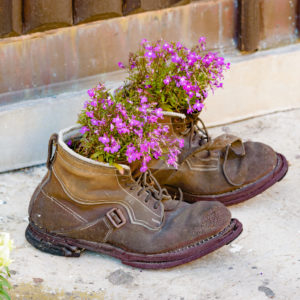Don’t throw out your 1980s Benetton sweater. Or that empty bottle of Cabernet. And certainly not the old Goodyear tire against the garage wall. All can now be creatively upcycled.
“Upcycled,” not recycled.
According to hipcycle.com, (is there a better named website for green enthusiasts?) upcycling is “the process of converting old or discarded materials into something useful and often beautiful.” A kind of repurposing for the masses, it’s a way of reducing the stuff in those bins on the curb.
By comparison, recycling (or downcycling) breaks down products, so their base materials can be remade into new products.
Virtually anything can be considered for upcycling — from the familiar (paper; “Square Paper Coasters”) to the far-flung (e-waste; a “Motherboard Cigar Case”). How about uprooting a warped vinyl INXS record for an updated notebook?
Referenced in the 1990s, it is thought that the word was first coined by modfathers William McDonough, (architect) and Michael Braungart, (chemist) in their 2002 book “Cradle to Cradle: The Way we Make Things.” It is goal oriented: a reduction in the consumption of raw materials.
Today, there is also a capitalist upside to upcycling. Habitat for Humanity has gone retail with “Restore.” Perhaps fearing a landscape of aluminum, Coca Cola promoted five “upcycled boutiques” in a 2014 story, “Trash to Treasure.” And Preserve Products, (whose motto is “Nothing wasted. Everything gained”) which remakes recycled products, counts among its corporate partners Whole Foods and Berry Plastics Corp.
Last month, The Wall Street Journal reported that high fashion is now creating “high-end upcycled clothing.” Designers are scouring archives and rummaging vintage stores for old garments that can be “refashioned.” Buyers are willing to pay a high price for such eco-conscious, upgraded clothes. Upcycling is now part of the curriculum of many fashion schools. Thimbles up!
Hipcycle reminds us that modern-day upcycling is rooted in 1930s-’40s America, when many families had very little economic or material resources. It says, “grandma was an upcycler.”
Uploading this column to your grandma might be considered a form of upcycling.

